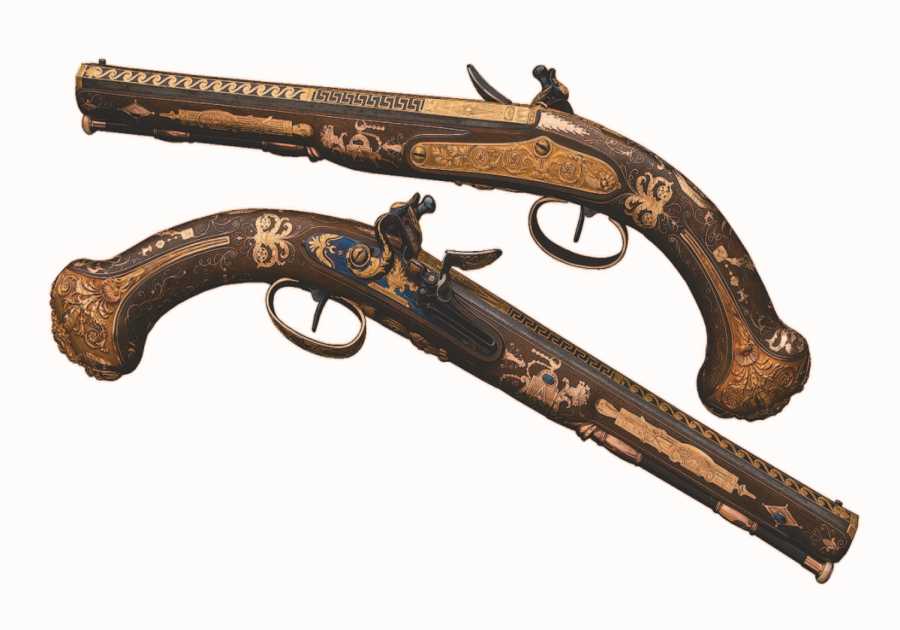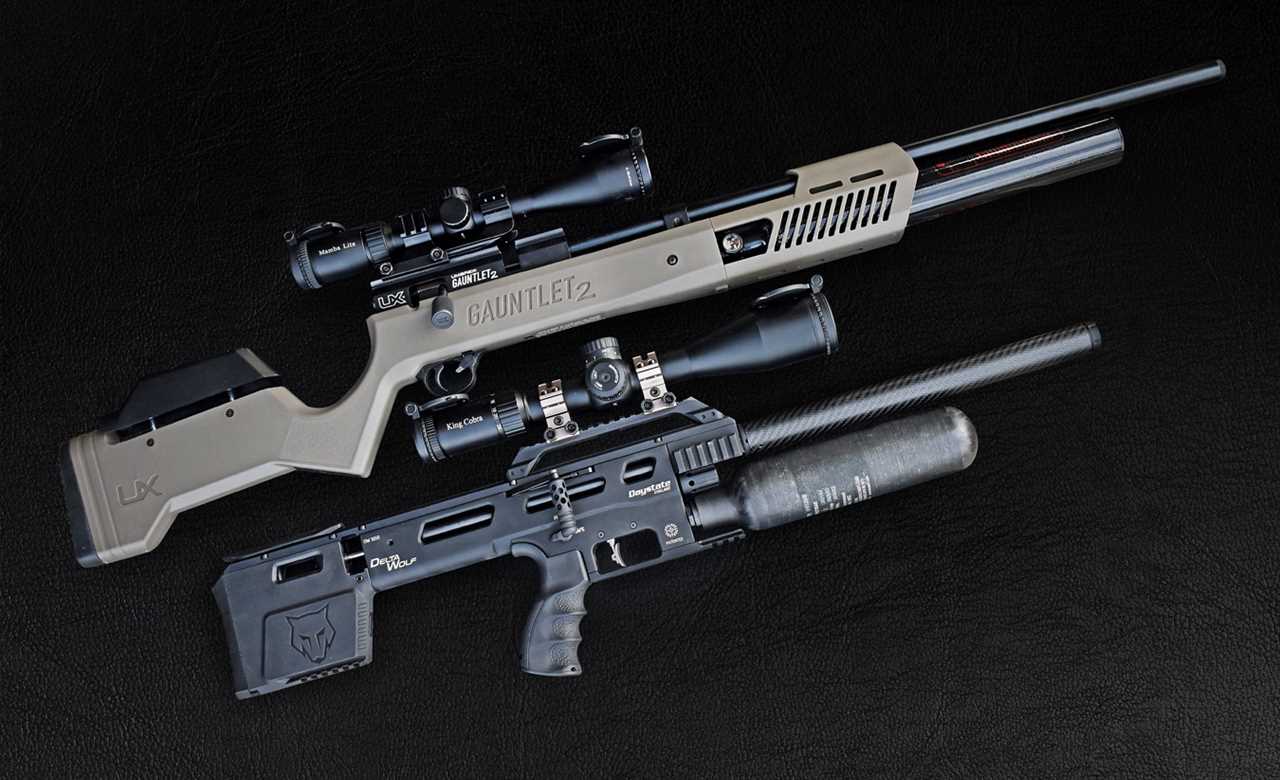
AMMO SHORTAGE IS OF NO CONCERN TO THOSE OF US BRAVE ENOUGH TO USE HIGH-PRESSURE AIR RIFLES TO SLING GLORIFIED LEAD FISHING WEIGHTS TO TAKE DOWN TARGETS FROM TOY SOLDIERS TO DEER
Here we are, one-fifth of the 21st century behind us. So it’s probably safe to assume that most folks reading this have at least a passing familiarity with paintball and airsoft guns, but maybe not “air rifle”.
Many probably still hear the word “airgun” or “air rifle” and immediately think of “Daisy,” “Red Ryder,” or simply “BB gun.” Others might recall “my old pump-up pellet gun.”
Would it surprise you to learn that there are a number of mass-produced airguns up to .50 caliber and capable of taking big game?
In fact, 23 states allow the use of big-bore (generally, .30 caliber and higher) airguns for taking deer-sized game, and efforts continue to bring more states into the fold.
And the best part is, with few exceptions, any adult can purchase and own these marvelous inventions without jumping through regulatory hoops and have them delivered to your door.
You may be wondering why this potential new hobby has escaped your radar for this long.
First, these are not the “entry-level” or low-end airguns found at the big-box stores; these bad boys are higher ticket items.
The Delta Wolf can accommodate a silencer such as this 0dB model and accessories like this handguard/bipod attachment. The magazine handles longer pellets like these polymer-tipped Polymags.
Second, the widespread perception was that “BB guns” were toys for boys, not for serious shooters, and definitely not for hunting. However, this being ’Merica, there was a faction that never outgrew their love of punching holes in tin cans, sniping enemy toy soldiers, or practicing until “strike anywhere” matches could consistently be lit with a single shot.
As this cadre of die-hards grew up, some were content with low power as long as they could get one-hole accuracy at 10 meters. These became the Olympic shooting aficionados purchasing European air rifles costing the equivalent of several mortgage payments.
Others wanted power from their airguns and excellent accuracy.
While American companies such as Crosman, Daisy, Sheridan, and Benjamin offered multi-pump pellet slingers that were well-made, relatively accurate, and powerful when pumped to their maximum level, some restless creative types experimented with building that better mousetrap and figuring ways to bring them to market.
Now, in the third decade of this century, multiple factors have converged to propel airgunning into the stream of consciousness.
The Second Amendment is under constant attack with a political climate that promotes shaming of those exercising that right. Fortunately, record numbers of people are exercising it, but the buying frenzy has caused an ammunition shortage and driven prices up. COVID kept us apart and looking for ways to entertain ourselves at home.
Conversely, due to modern polymers, carbon fiber, and improved manufacturing techniques, powerful and accurate airguns became affordable for just about anyone.
And, while COVID affected every supply chain, lead pellets are available at reasonable prices. Combined with the lack of regulation plus an uptick in interest in non-powder burning alternatives, these heavy hitters are becoming more mainstream.
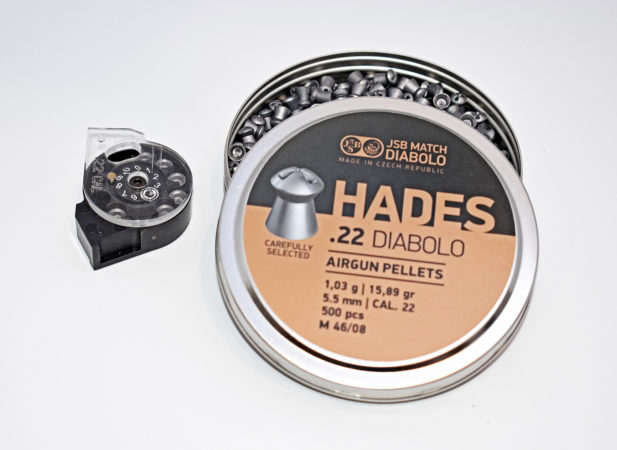
A .22-caliber Gauntlet2 magazine in the process of being loaded with JSB Hades pellets.
Technology to the Rescue
Where has all this tech and scientific advancement led the airgun world?
Two examples were plucked out of a myriad of possibilities in order to give a taste of what awaits if you choose to jump into this brave new world. Representing opposite ends of the price spectrum, they showcase the latest and greatest tech.
Both air rifles incorporate pre-charged pneumatic (PCP) powerplants, which means they have onboard, high-pressure air (HPA) cylinders providing the go-juice behind the pellet.

For serious PCP shooting, a SCBA tank is a good way to go. Here the D.W. is being topped off to 250 bar using an Omega tank from Airguns of Arizona.
How high a pressure? The Gauntlet2 has a working pressure of 4,500 psi, and no, your shop compressor won’t handle these bad boys.
The one drawback to getting started with PCP airguns is the extra up-front costs for an HPA handpump or compressor, although prices have come down drastically in the past few years.
Both models are bolt-action repeaters fed by spring-wound rotary magazines. From there, they diverge in features and capabilities.
Where it All Began
On this side of the pond, Crosman Corporation was a leader in using compressed CO2 gas to launch steel BBs and lead pellets. However, the power levels were limited and ambient temperature extremes could play havoc with shot velocities.
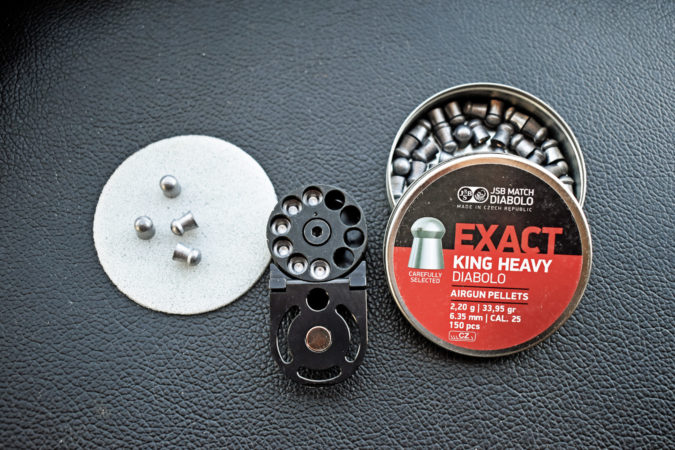
King Heavy .25 Cal airgun ammo
On the other side of the pond, around 40 years ago, creative types started a company called Daystate to make PCP air rifles. They were expensive, yet they were repeaters that didn’t require pumping between shots or fiddling with CO2 cartridges; plus, they offered beautiful old-world construction and craftsmanship.
Fast-forward to today and Daystate has become a leader in the PCP field and are a household name in the U.K. among the airgunning crowd.
Unfortunately for our British cousins and most other parts of the world, they’re limited to 12 foot-pounds of muzzle energy to remain legal to own without a permission slip. Luckily for us in the U.S., there are no such import restrictions so the Daystate Delta Wolf that’s covered here can be purchased in a .30-caliber model capable of 100 foot-pounds of energy.
Delta Wolf: Air Rifle Perfected?
- Daystate Delta Wolf in .25
- Action: Bolt action
- Power Source: Onboard, 250 bar removable HPA 480cc cylinder
- Weight: 8 pounds
- Overall length: 33 inches
- Stock Material: Synthetic
- Barrel: 23 inches
- Trigger: Two-stage adjustable
- Sights: None. Picatinny rail included for mounting optics
- Magazine: Rotary; 10-round steel with magnetic retention
- MSRP: $3,395
- Warranty: Five years for U.S. purchasers
- Country of Origin: Great Britain
- URL: DayState.com
The new Delta Wolf is a tactically styled bullpup PCP available in .177, .22, .25, and .30 with the sample rifle arriving in .25 caliber.
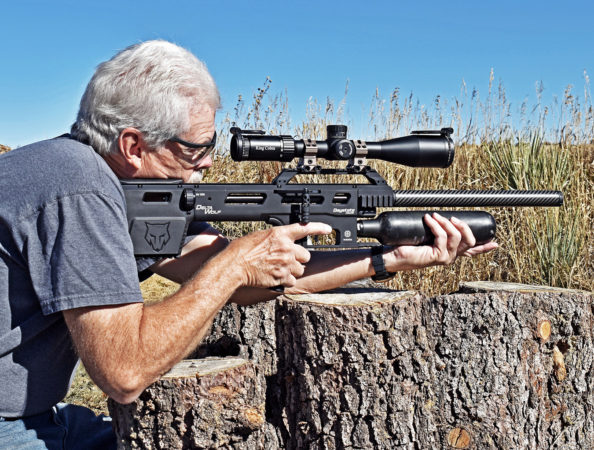
The Delta Wolf ready to pounce.
Designed from the beginning to be user-friendly for either handed shooters, it has an ambidextrous safety selector that’ll be very familiar to Modern Sporting Rifle shooters.
The safety is situated above a Mil-spec hand grip, so go for that aftermarket customized job if you desire.
A smooth-as-silk side cocking lever can easily be swapped from one side to the other with the provided Allen wrench and a flathead screwdriver. And, the cheekpiece is also adjustable and swappable.
Its receiver is nicely machined and finished in black with a 23-inch German-made rifled steel barrel covered by a black carbon-fiber shroud.
The muzzle has a removable cap to expose M20 (metric) threads for attaching an airgun silencer. Adapters to U.S. standard threading of 1/2×20 UNF are available should you wish to add suppression, not a bad idea since at the higher power settings the Delta Wolf can sling pellets at the supersonic threshold.
Overall length of the airgun is 33 inches. Under the barrel is the removable carbon-fiber-wrapped 480cc air bottle rated at a working pressure of 250 bar (3,625 psi).
Just above that is a knob used to adjust the Huma regulator as one method to control the power.
Decreasing regulator pressure can be done with the tank in place. Increasing the pressure requires removing the air tank and de-gassing the gun.
The match trigger is a two-stage job that’s fully adjustable using the supplied Allen wrenches. This sample rifle had been adjusted to be a hair-trigger that broke cleanly at less than half a pound and was a joy to use.
Moving back to the buttstock is where things really get interesting with the DW. You see, this is the world’s first electronically controlled PCP rifle.
Daystate has been refining their tech for years and released models with electronic triggers, but this is the first to incorporate control over the internal hammer strike and dwell (time the valve remains open) based on either pre-programmed factory settings or saved user inputs.
The onboard computer makes adjustments and provides a shot-to-shot consistency that can be tailored to the pellet weight being used and the style of shooting (field target, hunting, etc.).
This also helps the Delta Wolf to be stingy with the air in the tank by using only the amount needed to meet the preset choices.
The Future Is Now
How does the DW accomplish this? User input is done through a 1.75-inch color LCD screen built into the left side of the buttstock.
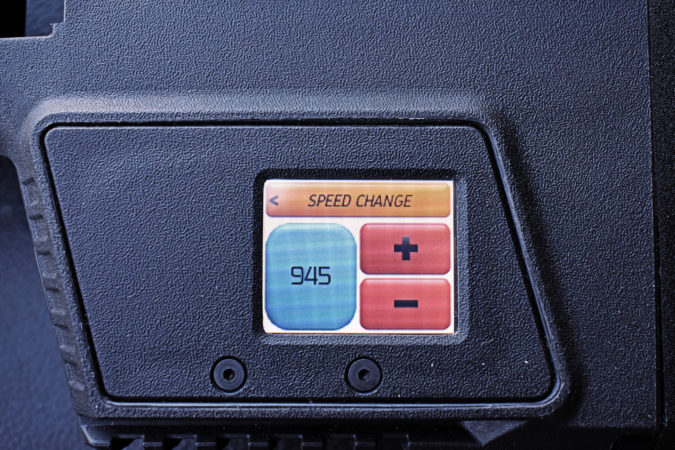
Close up of the color LCD in the Delta Wolf’s buttstock showing the pellet speed selector screen.
It’s activated by manipulating the safety lever, and the screen is locked until the bolt is opened and the trigger pulled slightly for 3 seconds.
The shooter can then scroll through pre-programmed menus or enter the Advanced Mode to install user-specific settings.
The U.S. distributor for Daystate, Airguns of Arizona, also programs in five additional settings before shipping the guns out. One of those has the acronym WARP — With All Reserve Power — which effectively provides maximum tuning for the caliber/pellet combination.
Still, how does the onboard computer know it’s providing the maximum tuning? Through the use of a chronograph module inside the carbon-fiber barrel shroud. Info on the muzzle velocity of each shot is fed back to the computer and visible on the LCD screen.
Wait! There’s More!
If all of these features weren’t enough to pique your interest, the Daystate engineers added a few other bells and whistles to boot.
An all-metal rotary magazine utilizes a flip-open door that makes loading pellets a snap. The .25-caliber version holds 10 rounds and accommodates long-skirted pellets as well as the new darlings of the high-power airgun world: slugs.
Strong magnets hold the magazine in place, and they can be inserted from either side. A nifty feature is that a magazine can be loaded on each side of the breech channel so that as one is emptied, the other can be pushed into place.
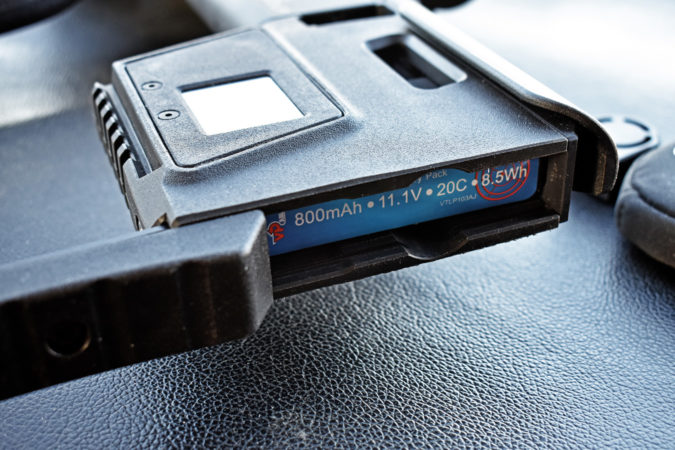
All of the Delta Wolf onboard electronics are powered by this LiPo battery stored in the buttstock.
Ample Picatinny rails are incorporated, the buttstock is vertically adjustable for fit, and a long, quick-detach female foster fitting with a slow-fill feature is included. This feature prevents the air tank from filling too quickly and causing heat buildup, which should be avoided.
Another value-add is that this is a system with barrels, magazines, and breech bolts that can be purchased in the other calibers for easy swaps.
Additionally, a five-year warranty is provided to U.S. customers, it comes in a foam-lined, hard-sided plastic case, and Bluetooth capability is built in for future features and updates.
Jolly Good
Airguns of Arizona provided a 6-24x50mm MTC brand King Cobra first focal plane scope to try out with the DW.
It added 30 ounces to the 8-pound weight of the DW yet felt good in the hands, and the combination worked very well.
The DW shot like a dream with JSB Exact and Predator Polymag pellets, and accuracy was impressive — as you’d expect from an airgun at this price level. The only complaint at this point is the lack of ability to input pellet weights as opposed to having to select pre-programmed weights.
As more .25- and .30-caliber pellets come to market, this will be needed to wring the most out of the DW. Daystate can update this in the future.
With a list price of $3,395, being on the bleeding edge of technology certainly isn’t cheap.
Throwing Down the Gauntlet2
- Umarex Gauntlet2 in .22
- Action: Bolt action
- Power Source: On-board, 310 bar removable HPA 393cc cylinder
- Weight: 8.5 pounds
- Overall Length: 47 inches
- Stock Material: Synthetic
- Barrel: 28.5 inches
- Trigger: Single-stage adjustable
- Sights: None. Picatinny/dovetail rail combination
- Magazine: Rotary; 10-round in .22; 8 rounds in .25
- MSRP: $450
- Warranty: Three years
- Country of Origin: China and U.S.; assembled in U.S.
- URL: UmarexUSA.com
- Resources:
Not to be outdone, companies here in the U.S. have been producing powerful PCP airguns since the 1990s. As is typical when a market begins to open up, other players get in the game. With more competition and innovation, prices tend to come down.
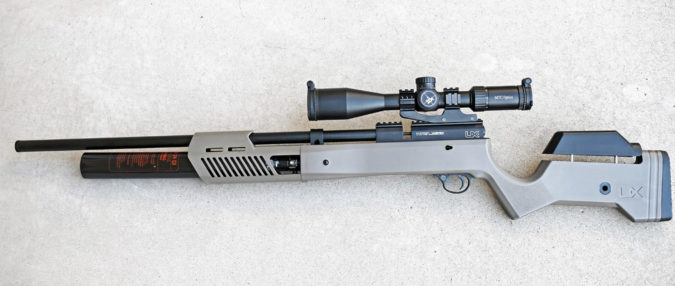
The new Gauntlet2 sports lines resembling a precision rifle chassis.
Umarex USA’s newest offering, the Gauntlet2, is an example of this. It’s the second generation of a very popular PCP for the company that was introduced in 2017 and checked a whole bunch of boxes for price, quality, power, adjustability, and accuracy.
Demand was great and so was the feedback to Umarex for improvements and — what else? — more power.
The challenge was to give the public what it wanted, while keeping quality high and the price low, so the Gauntlet2 took what worked in the Gauntlet and improved upon it.
There were three calibers of the original: .177, .22, and .25, but the new Gauntlet2 only offers .22 and .25.
More Power
Another major change is the boosting of the air reservoir pressure from 3,000 to 4,500 psi and increasing the cubic-inch volume from 13 to 24 (393cc).
This allows for a higher internal regulator pressure of 1,900 psi for the .22 model and 2,100 for the .25. In turn, this provides over 50-percent more power for the shot while still having enough volume for a 60- or 50-plus shot string, respectively, before needing to refill the air reservoir.
The aluminum billet receiver is anodized matte black and well finished with no visible machine marks, a sign of quality unexpected at this price point and great to see.
An oversized, knurled steel cocking knob projects from the right side and isn’t swappable for lefties. It’s topped by a 7.5-inch combination Picatinny/11mm dovetail rail for mounting optics. This combination is a welcome design feature for those owning scope rings made specifically for airgun scopes.
Modern Features
The internal steel rifled barrel is enclosed in a 26-inch matte black aluminum shroud containing baffles to reduce the rifle’s report. This baffling works great unless you shoot lightweight pellets because the Gauntlet2 can sling them at supersonic speeds, causing a loud crack.
With the purchase of an aftermarket adapter, a silencer can be added, but at an overall length of 47 inches already, that may not be desirable.

The Umarex Gauntlet2 ready for launch — of a pellet.
A tan-colored precision rifle-style synthetic stock has replaced the original black blocky and heavy stock of the Gauntlet. An adjustable black cheek riser, black rubber buttpad, and black trigger guard provide a pleasing contrast.
The removable forearm partially covers the long air tank, which is also removable from the air rifle. It has M-LOK slots at the 3, 6, and 9 o’clock positions, and due to the forward heavy center of gravity of this air rifle, this is a welcome addition so that a bipod can be added. A single-point QD sling attachment point is molded into the buttstock as well.
The trigger is an adjustable single-stage unit with a safety lever incorporated at the front of the trigger guard. A very nice trigger for an airgun at this price point, it does require removal from the stock to make adjustments.
Out of the box, the pull was a perfectly adequate 1 pound, 12.5 ounces.
Hitting The Range
Because cocking the air rifle sets a powerful internal hammer spring, the effort is stout. But the oversized cocking knob helps by providing additional purchase and leverage. The extra power of the Gauntlet2 makes this effort worthwhile as the .22-caliber muzzle energy developed with 15.89-grain pellets was a respectable 36.5 foot-pounds.
Two spring-wound rotary magazines, each holding 10 rounds, are included in the kit plus a single-shot loading tray. These are the same magazines used in the Gauntlet, so are interchangeable.
Unfortunately, they don’t accommodate some longer pellets/slugs, so that’s where the single-shot tray comes into play.
The air rifle weighs in at 8.5 pounds and comes without sights. An MTC Mamba-Lite 4-16x42mm scope provided by Airguns of Arizona added 1.5 pounds to the package, and this pairing worked very well.
The accuracy of the Gauntlet2 was excellent across a range of pellets used. Airguns can be finicky when it comes to pellets, but that wasn’t the case with the Gauntlet2. Pellets in .22 caliber are abundant in the marketplace, making it easy to try a multitude of brands and weights. The Gauntlet2 seemed to digest almost all of them with good-to-excellent accuracy. Lastly, a three-year warranty is provided with the Gauntlet2.
One product cannot be all things to all people and, of course, so it is with the Gauntlet2. Some give ups at this price point include not being able to adjust the trigger in situ and a tiny pressure gauge that’s difficult to read. Not deal breakers by any means. For those interested in PCP air rifles, the Gauntlet2 may not be cutting edge, but it’s a great performer for the list price of $450.
Ready For More Airguns? Take a look!
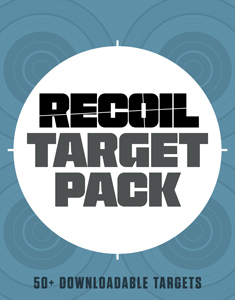
NEXT STEP: Download Your Free Target Pack from RECOIL
For years, RECOIL magazine has treated its readers to a full-size (sometimes full color!) shooting target tucked into each big issue. Now we’ve compiled over 50 of our most popular targets into this one digital PDF download. From handgun drills to AR-15 practice, these 50+ targets have you covered. Print off as many as you like (ammo not included).
Get your pack of 50 Print-at-Home targets when you subscribe to the RECOIL email newsletter. We’ll send you weekly updates on guns, gear, industry news, and special offers from leading manufacturers – your guide to the firearms lifestyle.
You want this. Trust Us.


